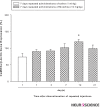Gene Expression Profile of Calcium/Calmodulin-Dependent Protein Kinase IIα in Rat's Hippocampus during Morphine Withdrawal
- PMID: 25337341
- PMCID: PMC4202531
Gene Expression Profile of Calcium/Calmodulin-Dependent Protein Kinase IIα in Rat's Hippocampus during Morphine Withdrawal
Abstract
Introduction: Calcium/calmodulin-dependent protein kinase II (CaMKII) which is highly expressed in the hippocampus is known to play a pivotal role in reward-related memories and morphine dependence.
Methods: In the present study, repeated morphine injections once daily for 7 days was done to induce morphine tolerance in male Wistar rats, after which gene expression profile of α-isoform of CaMKII (CaMKIIα) in the hippocampus was evaluated upon discontinuation of morphine injection over 21 days of morphine withdrawal. Control groups received saline for 7 consecutive days. For gene expression study, rats' brains were removed and the hippocampus was dissected in separate groups on days 1, 3, 7, 14, and 21 since discontinuation of of morphine injection. A semi-quantitative RT-PCR method was used to evaluate the gene expression profile.
Results: Tolerance to morphine was verified by a significant decrease in morphine analgesia in a hotplate test on day 8 (one day after the final repeated morphine injections). Results showed that gene expression of CaMKIIα at mRNA level on day 1, 3, 7, 14 and 21 of morphine withdrawal was significantly altered as compared to the saline control group. Post hoc Tukey's test revealed a significantly enhanced CaMKIIα gene expression on day 14.
Discussion: It can be concluded that CaMKIIα gene expression during repeated injections of morphine is increased and this increase continues up to 14 days of withdrawal then settles at a new set point. Therefore, the strong morphine reward-related memory in morphine abstinent animals may, at least partly be attributed to, the up-regulation of CaMKIIα in the hippocampus over 14 days of morphine withdrawal.
Keywords: Gene Expression; Hippocampus; Morphine withdrawal; Semi-Quantitative RT-PCR.
Figures


Similar articles
-
Epinephrine inhibits analgesic tolerance to intrathecal administrated morphine and increases the expression of calcium-calmodulin-dependent protein kinase IIalpha.Neurosci Lett. 2008 Jan 17;430(3):213-7. doi: 10.1016/j.neulet.2007.10.038. Epub 2007 Nov 6. Neurosci Lett. 2008. PMID: 18053645
-
Increased calcium/calmodulin-dependent protein kinase II activity by morphine-sensitization in rat hippocampus.Behav Brain Res. 2014 Jul 1;267:74-82. doi: 10.1016/j.bbr.2014.03.035. Epub 2014 Mar 25. Behav Brain Res. 2014. PMID: 24675163
-
5-HT2A Serotonin Receptor Density in Adult Male Rats' Hippocampus after Morphine-based Conditioned Place Preference.Basic Clin Neurosci. 2016 Jul;7(3):249-58. doi: 10.15412/J.BCN.03070310. Basic Clin Neurosci. 2016. PMID: 27563418 Free PMC article.
-
Differential expression of H19, BC1, MIAT1, and MALAT1 long non-coding RNAs within key brain reward regions after repeated morphine treatment.Behav Brain Res. 2021 Sep 24;414:113478. doi: 10.1016/j.bbr.2021.113478. Epub 2021 Jul 21. Behav Brain Res. 2021. PMID: 34302875
-
Increased expression of Ca2+/calmodulin-dependent protein kinase II alpha during chronic morphine exposure.Neuroscience. 2004;123(3):769-75. doi: 10.1016/j.neuroscience.2003.10.007. Neuroscience. 2004. PMID: 14706789
Cited by
-
Association of morphine-induced analgesic tolerance with changes in gene expression of GluN1 and MOR1 in rat spinal cord and midbrain.Iran J Basic Med Sci. 2016 Sep;19(9):924-931. Iran J Basic Med Sci. 2016. PMID: 27803778 Free PMC article.
-
Morphine-Induced Analgesic Tolerance Effect on Gene Expression of the NMDA Receptor Subunit 1 in Rat Striatum and Prefrontal Cortex.Basic Clin Neurosci. 2016 Jul;7(3):241-8. doi: 10.15412/J.BCN.03070309. Basic Clin Neurosci. 2016. PMID: 27563417 Free PMC article.
References
-
- Ammon-Treiber, S., &, Hollt, V. (2005). Morphine-induced changes of gene expression in the brain. Addict Biol, 10, 81–89 - PubMed
-
- Andersen, J. M.,, Klykken, C., &, Morland, J. (2012). Long-term methadone treatment reduces phosphorylation of CaMKII in rat brain. J Pharm Pharmacol, 64, 843–847 - PubMed
-
- Bayer, K. U., &, Schulman, H. (2001). Regulation of signal transduction by protein targeting: the case for CaMKII. Biochem Biophys Res Commun, 289, 917–923 - PubMed
-
- Bayer, K. U.,, De Koninck, P.,, Leonard, A. S.,, Hell, J. W., &, Schulman, H. (2001). Interaction with the NMDA receptor locks CaMKII in an active conformation. Nature, 411, 801–805 - PubMed
-
- Benyamin, R., Trescot, A. M., Datta, S., Buenaventura, R., Adlaka, R., Sehgal, N., et al. . (2008). Opioid complications and side effects. Pain Physician, 11, S105–120 - PubMed
LinkOut - more resources
Full Text Sources
